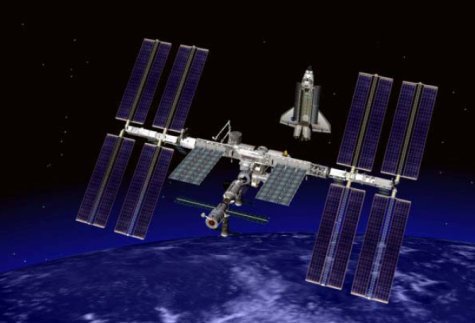Space Station Construction Visible in Backyard Telescopes
International Space Station and Space Shuttle — These will be visible with backyard telescopes. (science.nasa.gov)
Talk about a big construction project…
Astronauts are about to add a pair of 115-foot-long solar wings to the International Space Station. The station’s solar arrays are the largest deployable space assemblies ever built and the most powerful electricity producing arrays in orbit. Each wing weighs 2,400 pounds, uses 32,800 individual solar cells, and adds about 4000 sq. feet of light-collecting surface area to the ISS. When the work is done, the space station will have enough usable electricity to light up 42 houses.
Amateur astronomers can see it happen with their own eyes.
The International Space Station is so large, its outlines are visible in backyard telescopes. “In December, the space station made a nice pass over my backyard observatory,” says photographer Ralf Vandebergh of the Netherlands. “It was about as bright as Venus—you couldn’t miss it.” He hand-guided his telescope to keep the ISS centered in the field of view and captured the image using a digital video camera attached to the eyepiece.
The new wings are en route to the ISS onboard space shuttle Discovery, which left Earth on Sunday, March 15, in a beautiful twilight launch from Kennedy Space Center. In addition to the solar arrays, Discovery is also bringing a 31,000-lb truss segment to complete the station’s massive backbone and a thermal radiator to shed heat from newly-powered electronics. If all goes according to plan, the arrays, truss segment, and radiator will be installed during a spacewalk on mission Day 5 (March 19); the arrays will be unfurled accordian-style on mission Day 8 (March 22).
The timing of these events favors sky watchers in the USA and Canada. The ISS (with Discovery docked) is due to fly over many North America towns and cities after sunset in mid- to late-March. Shining brighter than any star, the ISS-Discovery combo takes a leisurely 5 minutes to glide across the sky—plenty of time to point a telescope, take a picture, or just soak up some of the station’s growing luminosity.
Today, March 17, at 8:12 p.m. both the Space Station and the Space Shuttle will be visible with back yard telescopes. There will be a three minute widow of visibility. The approach will be from the North West moving out of sight in the North- North East.

